|
Opened in July 1940 Westhampnett was used as a
fighter station by the RAF before handed over to the USAAF in July 1942. It was on the 26th July that the 31st Fighter group
became the first US fighter unit to start ops in the European arena. Up until March 1945 various US and RAF fighter units
used the airfield and it was closed shortly until July 1945 when a Royal Navy unit moved in. This left in November 1945 and
was placed into care until closure on the 13th May 1946. The airfield was transformed into the Goodwood racing track shortly
after the war.
G-AZSC was built for the USAAF in 1943 and delivered
to the RAF in 1944 as a training platform for pilots who were destined to move onto single engined fighter aircraft. After
being sold to Royal Netherlands AF, she moved into the civil market place and undertook various roles including that of a
sign writer.
One of her more notable owners was that of Gary Numan,
who in partnership with Norman Lees, who later tragically died in a Spitfire training accident at Goodwood, flew
as "The radial pair" display team.
Sporting a dashing black colour scheme undertaken by
Numan prior to her sale she now resides at Goodwood aerodrome and along with being used for warbird experience flights, she
is also one of the few Harvards in the UK, where pilots can be trained, under tuition from Goodwood Aero Club instructors, to
fly vintage aircraft on there way to flying the more faster Mustangs and Spitfires.
She is meticulously maintained by the Goodwood maintenance team
and brings a welcome addition the Aeroclub as the first of what looks to be a future trend at Goodwood to bring the thrill
of clasic flying to the man in the street with a hint of maybe the purchase of other warbirds, that will grace the Sussex
skies.
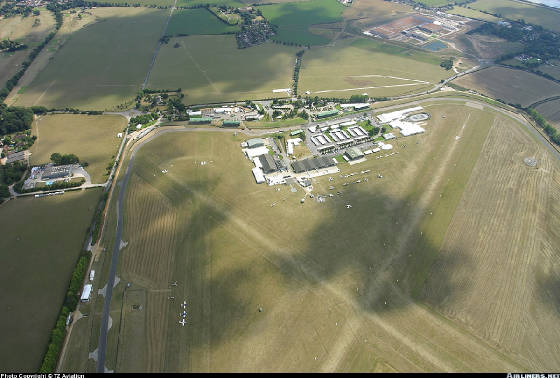
This page, the history of the Harvard
Page 2. Walkround
Page 3. The Pilot, (Oberleutnant) Hans Dieter Sinanan.
Page 4. On the wing
Page 5. The Aero Club
Page 6. Douglas Bader
Page 7. Lee Proudfoots first of 2009
Page 8. The Harvard trio
|
Serial #: 43-13064
Construction #:
14A-1363
Civil Registration:
PH-SKK
G-AZSC
Model(s):
AT-16
Mk.
IIB
Name: The beast
Status: Airworthy
Last info: 2008
|
|
History:
Built for USAAF as 43-13064, 1943.
Delivered
to RAF as FT323, Jan. 1944-1946.
Delivered to Royal Netherlands AF as B-19, Nov. 28, 1946.
C. Honcoop, Veen, Netherlands,
circa 1969.
J. Daams/Skylight NV, Loosdrecht, Feb. 10, 1970.
- Registered as PH-SKK.
Sold to owner in USA (never
delivered), struck-off civil registry, Nov. 19, 1971.
R. N. Rijken, Jan, 5, 1972.
- Reregistered as PH-SKK.
Sold
to owner in Switzerland (never delivered), struck-off civil registry, Jan. 14, 1972.
Doug W. Arnold/Fairoaks Aviation Services,
UK, Apr. 7, 1972-1977.
- Registered as G-AZSC.
- Delivered to Fairoaks from Holland, Jan. 12, 1972.
- Flew initially
as RAF/FT830 (later as RAF/FT323.
Michael W. Stowe, Blackbushe, UK, Nov. 2, 1977-1981.
Doug W. Arnold/Warbirds of GB,
Blackbushe, UK, Jan. 5, 1981-1984.
Gary Numan/Machine Music Ltd, Fairoaks (later White Waltham), North Weald, Duxford,
UK, Feb. 28, 1984-2002.
- Flew in Japanese Zero scheme.
Sold through Meridian Aircraft sales to Goodwood Aero club in
2005, now used for warbird experience flights, training and as a display aeroplane for Goodwood Aero club, piloted by Dieter
Sinanan. |
In detail
In 1934 the US government issued
a contract for a primary trainer to meet the ever expanding US Army Air Corps training requirement. In answer, North American
Aviation, based in Southern California answered with what would ultimately become the most numerous training aircraft ever
produced.
The first prototype, the North American NA-16, which first
flew on 1 April 1935, evolved into the AT-6 Texan. This aircraft was produced in several variants, with several power plants
ranging from 400 to 600hp. Production initially started with the BT-9 type for the US Army Air Corps in 1936 with a contract
for 95 and this series was again ordered in 1937 with a contract for 248. In 1937 the addition of retractable undercarriage,
a Pratt and Whitney R-1340 power plant and some other refinements to the airframe produced what is now seen as the classic
“Harvard” shape. Further developments with construction and different materials led to the AT-6A, which was first
produced in 1939.
With America’s entry into WW2 in December 1941,
production of the intermediate trainer was contracted out under licence to several companies, one of those being Noordyne
Aircraft Ltd. Based in the old Curtiss-Reid Aircraft factory in Montreal, Canada, Noordyne began construction of AT-16 aircraft
(a licensed version of the AT-6A). Eventually the factory produced 3,985 examples, mainly for the USAAF and RCAF, by the time
of the sale of the company in 1946. By end of production, in total over 17,000 “Harvard” aircraft of all variants
had been produced
G-AZSC was built by the Noordyne factory, rolling off
the production line on the 2nd November 1943 and was allocated the USAAF serial 43-13064. After the factory test flight she
was selected for shipment to the RAF and was ferried to Newark, New Jersey. Shipped aboard the SS Morgenue, she departed dock
on the 24th December 1943, arriving in Liverpool docks on the 6th January 1944. SC was allocated the RAF serial FT323 and
was shipped by road to 46 Maintenance Unit at RAF Speke (now Liverpool John Lennon Airport) arriving there on the 13th
February 1944.
During 1943, 46 MU had been tasked with the mass assembly
of USAAF aircraft arriving in the UK in preparation for D-DAY, SC of course was one of these and following assembly stayed
at Speke as a communications aircraft. Rootes Securities, also based at RAF Speke, had in 1941 been awarded a contract for
building Halifax aircraft. In November 1944 with the war progressing and demand for increased aircraft production, SC transferred
to Rootes to be their communications aircraft. Evidently SC was not a popular aircraft for this task as by the 6th
February 1945, she had been transferred back to 46 MU and was put in storage.
On the 29th October 1946 SC was removed from
storage and put back in the air in preparation for a new life in continental Europe. In November 1946 SC was transferred to
the Royal Netherlands Air Force, being accepted by them on 26th December 1946 and given the serial B-19. The Royal
Netherlands Air Force had been almost completely wiped out during the German invasion in 1940. A few crews had escaped to
England and served with the RAF throughout the war, however following cessation of hostilities, the RAF showed its appreciation
of the Dutch by donating aircraft to rebuild its armed forces. It seems however that, this somewhat dated technology by then
wasn’t so well received and SC was subsequently shipped to Sweden in 1947.
Used very little, it next appears on the register in 1969
in private hands based at Veen, in the Netherlands. Here, with its new registration of PH-SKK she was used by a Skywriting
company, and was fitted with an oil smoke system. It appears though, that love for her was not high, as there were two attempts
to sell her, firstly to the USA in November 1971, and then again to Switzerland in January 1972, both times the sale fell
through. However in April 1972 she was bought by Doug Arnold at Fairoaks to be part of his expanding collection of aircraft.
His Warbirds of Great Britain Collection is responsible for saving many of the historic aircraft we enjoy seeing today, this
Harvard being one of them.
When Doug bought her she was in a blue and gold paint
scheme, and he chose to paint her in what he thought to be her original RAF scheme. Confusion led to her being painted as
RAF Harvard FT830, before her proper identity of FT323 was discovered. Sold to Michael Stowe, she moved to Blackbushe airport
from November 1977, a move only temporary, as Doug Arnold bought her back again in January 1981. Here enters 80s pop star,
Gary Numan.
Gary had always wanted to be a pilot, and although having
attended Brooklands Technical college, lacked the academic qualifications for the airlines. He had however enjoyed some time
in the Air Training Corps, and with a Private Pilots License and a love for old aeroplanes. He bought SC from Doug in February
1984. He painted her to look like a Japanese “Zero” fighter and for many years he flew her on the display circuit,
appearing at shows across the UK and Europe. Gary formed the Radial Pair, a Harvard aerobatic display team with his friend
Norman Lees, this eventually grew to become a group display with up to 5 Harvards taking part.
During the 80s and 90s as Gary moved around so did SC,
being based successively at Fairoaks, White Waltham, and North Weald. With increasing hours being logged, her paint was fading
and it was decided by Gary to paint her in her current scheme in 1996, before a move to Duxford in Cambridgeshire. Here Gary
kept her until October 2005 when she was sold to Goodwood Road Racing Company, moving to her current home at Goodwood shortly
after.
SC now earns her keep introducing people to the technicalities
of heavier tail wheel aircraft. Ideal both for training and pleasure flying, SC was an aircraft that Plane Heritage has long
wanted to offer flights in. After some negotiating Plane Heritage and Goodwood Road Racing Company came to an agreement in
December of 2008, and we are delighted to have this aircraft available to us from the start of 2009.
North American AT-6 Harvard Specifications
|
Aircraft Type: |
North
American AT-6 Harvard |
|
Mark: |
AT-6 Mk I,II, III |
|
Primary Role: |
Combat
trainer |
|
First Flight: |
1
April 1935 as the NA16 prototype |
|
Date operating with FAA squadrons: |
1943-1955
(with FAA air crew 1940 onwards under the BCATP) |
|
Manufacturer: |
North
American Aviation Inc., Los
Angeles Municipal Airport,
Inglewood, California, U.S.A.
Canadian Car & Foundry
Noorduyn Aviation Limited, Montreal, Canada |
|
Engine: |
One
600hp Pratt &Whitney R-1340-AN-1 engine |
|
Wing Span: Length: Height: Wing Area: |
Span
: 12.8m (42'0ft)
Length : 8.99m (29'6ft)
Height : 3.56m (11'8ft) |
|
Empty Weight: Max.Weight: |
empty
: 1,938kg (4,271lb)
max : 2,546kg (6,617lb) |
|
Speed:
Ceiling:
Range: |
max
speed : 341km/h (212mph)
max climb : 1,643ft/min (8.3m/sec)
ceiling : 24,750ft (7338m)
range
: 1400km (870miles) |
|
Armament: |
None |
|
Crew: |
2 |
|
Squadrons: |
702,709,715,718,721,726,727,728,729,732,741,748,750,757,758,759,761,766,767,768,778,780,781,
782,784,789,794,795, 797,798,799 |
|
Battle honours: |
None
with FAA |
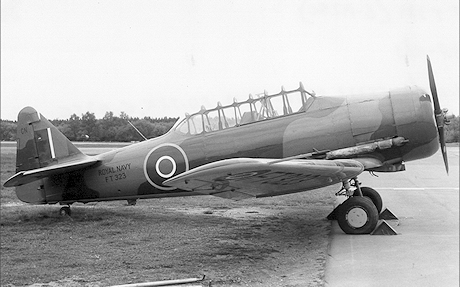
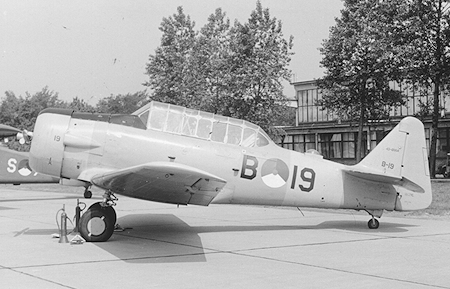
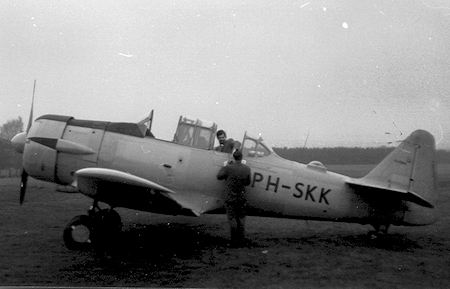
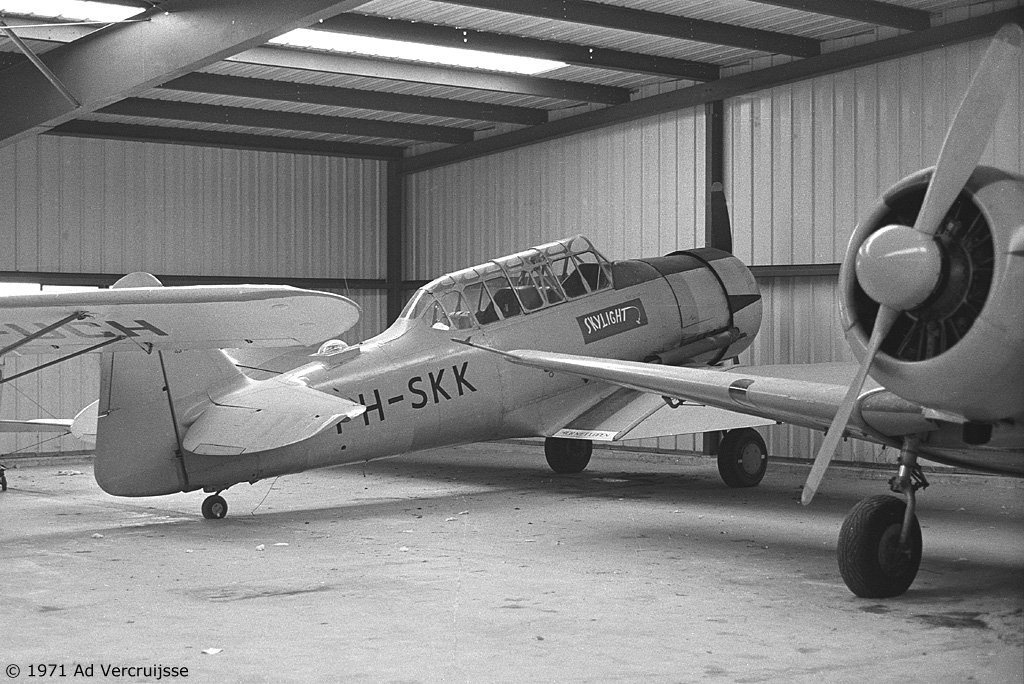
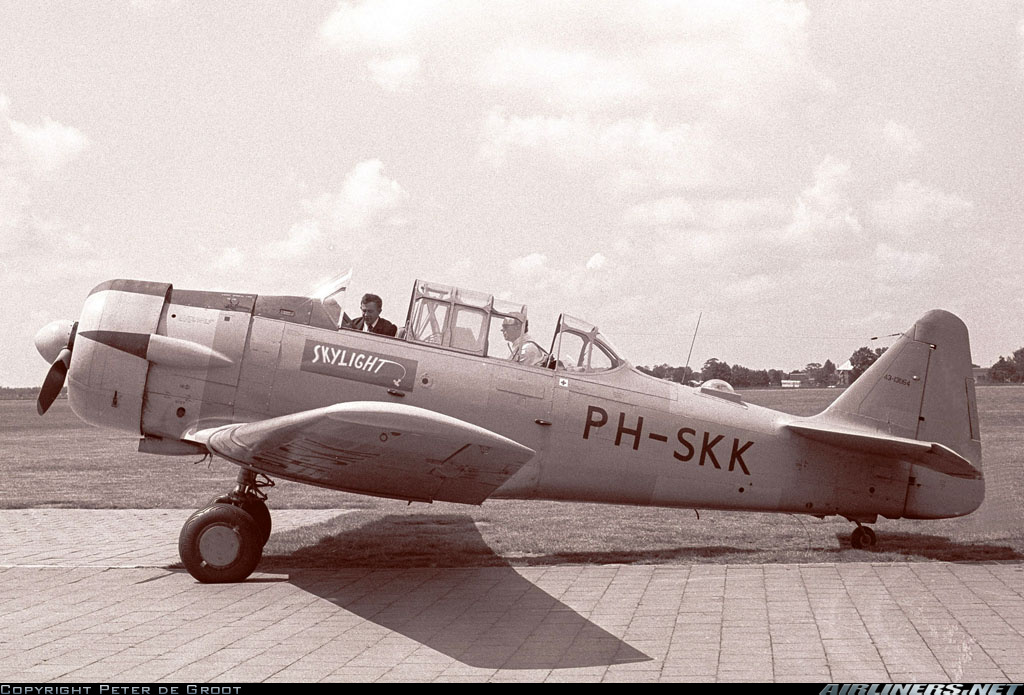
.
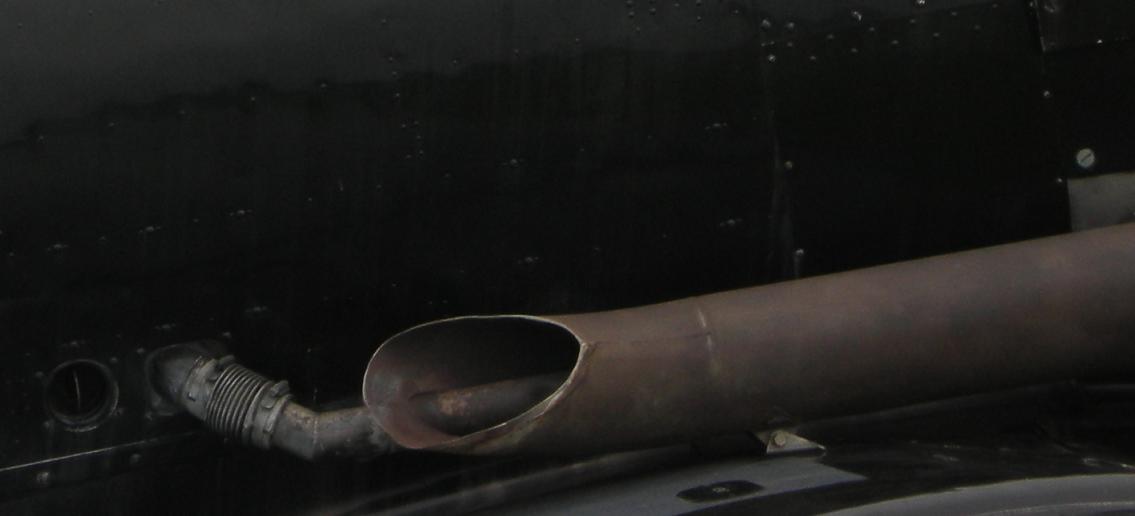
After her tour of duty with the USAAF and RAF she was
sold into the civilian market and back in the 70's, re-registered as PH-SKK was used for Skywriting. On nice days she would
fly over Zandvoort Beach and write the "Roxy" cigarette name. Oil was fed into the exhaust system via a small holding tank
to create the smoke.
The same set up still exists today in the Goodwood Harvard.
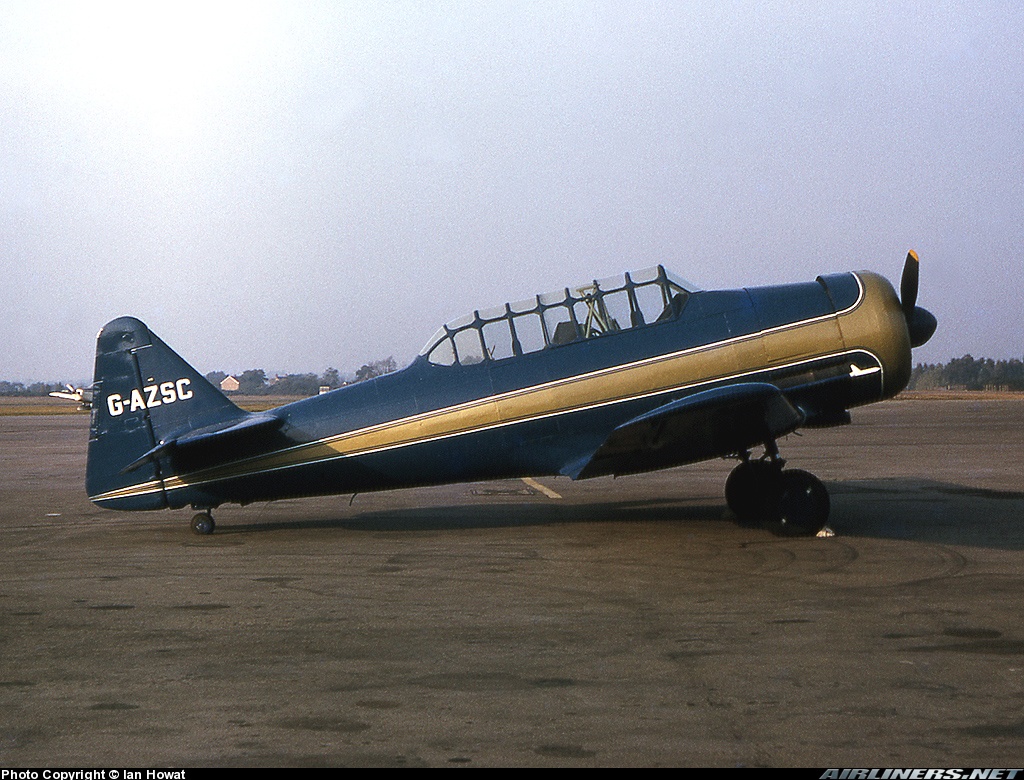
The above shot shows "SC" when she was owned by Doug W. Arnold of
Fairoaks Aviation Services, here she is at Blackbush in 74 in a striking colour scheme

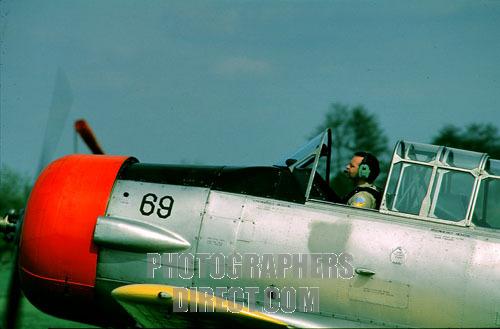
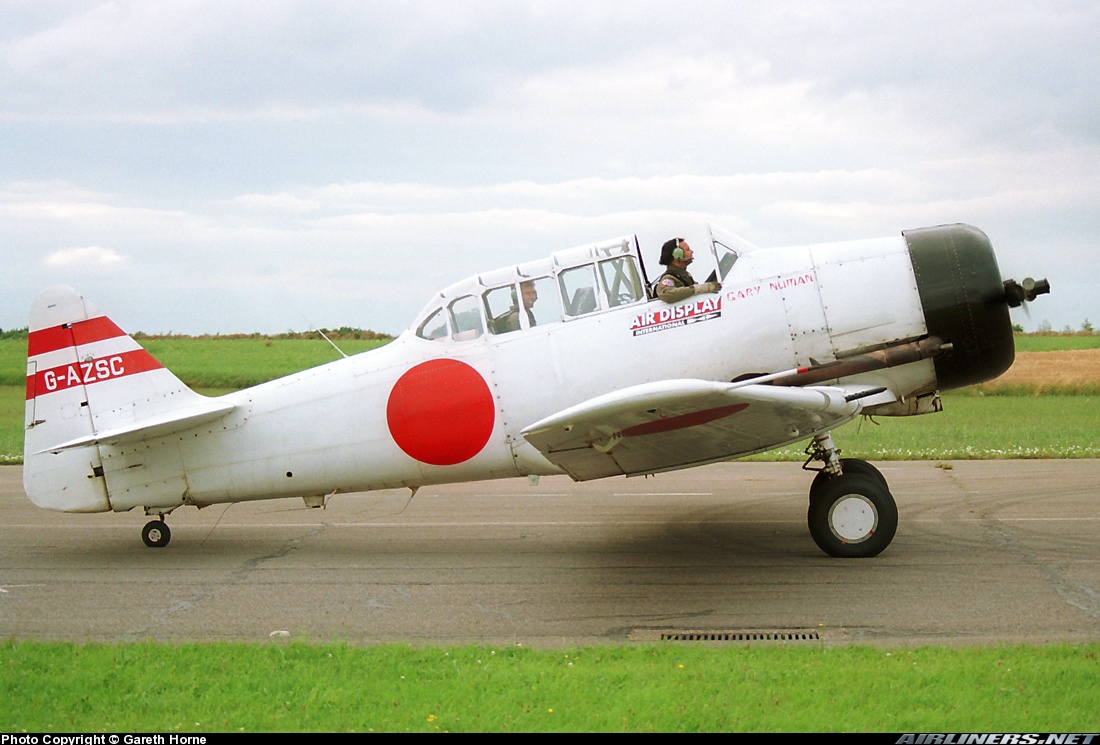
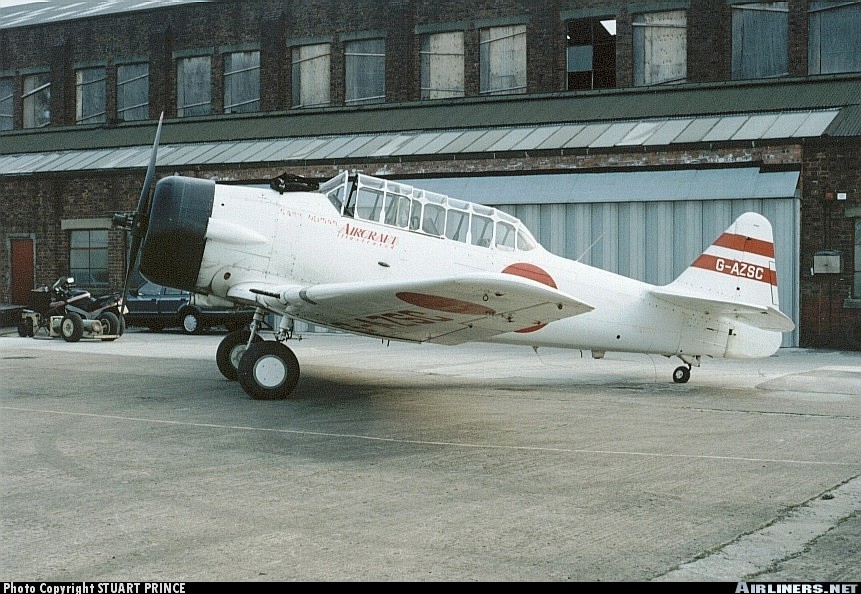
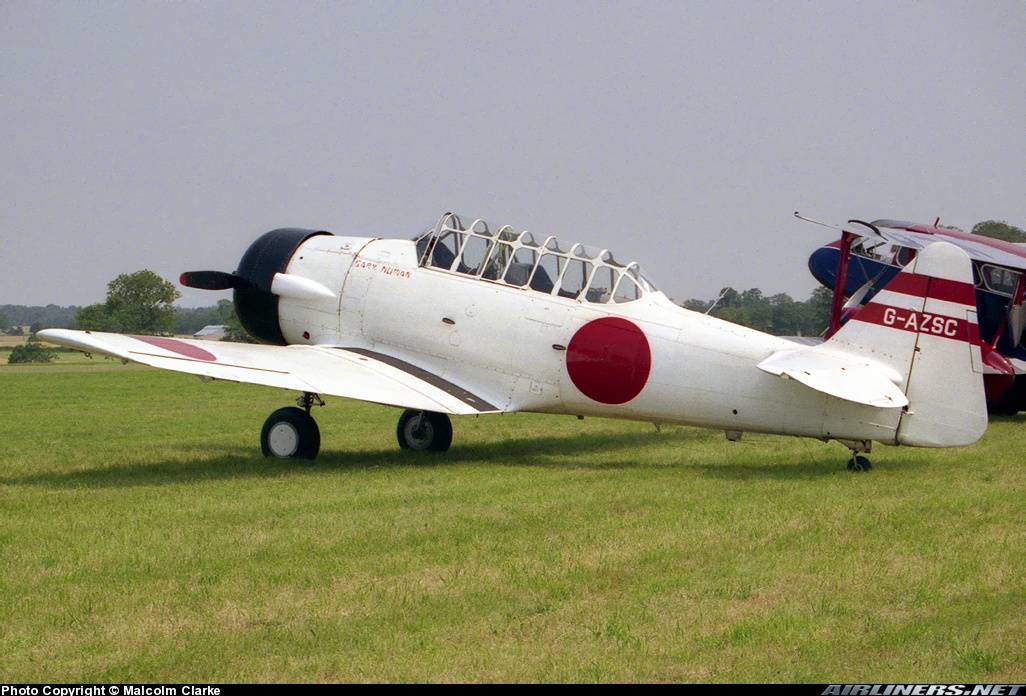
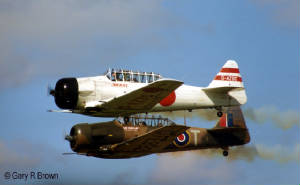
The above shot shows Norman Lees with Gary Numan, when
they displayed as the "Harvard Formation Team"

The above seven shots show the Goodwood
Harvard when she belonged to Gary Numan
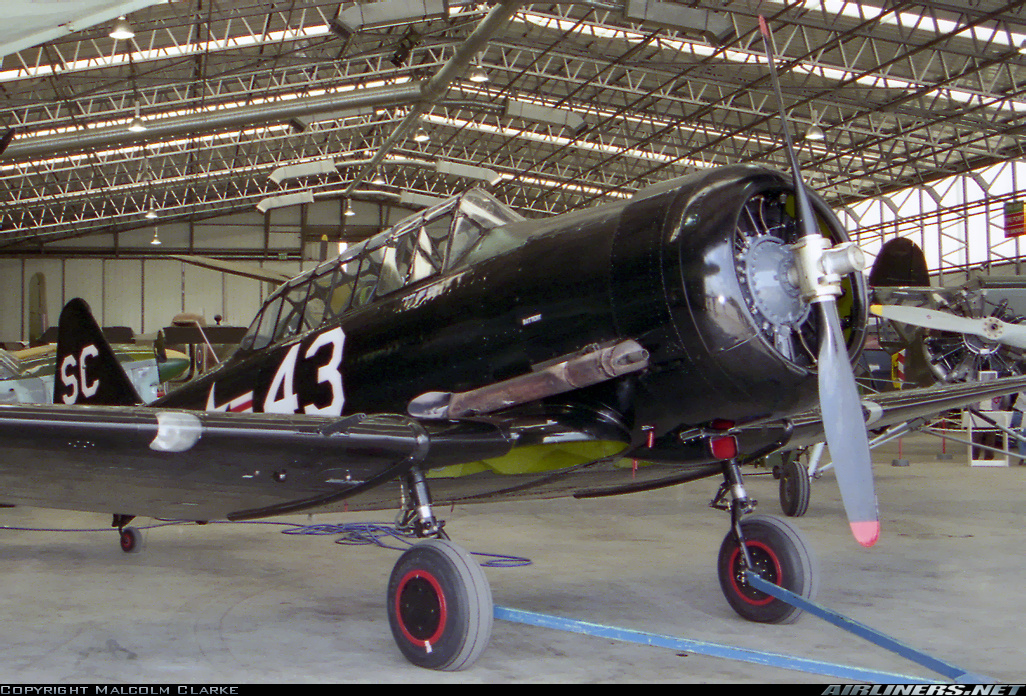
Undergoing maintenance at Duxford

.............As she leaves her old home at Meridian, Bournemouth
for delivery to Goodwood
Above is me with Sierra Charlie at Legends in 2007
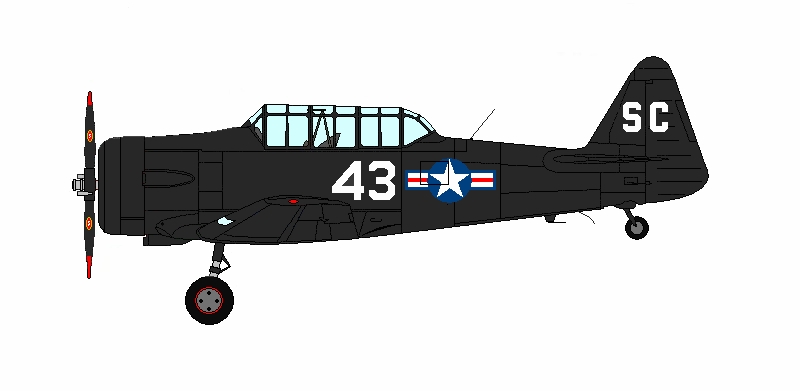
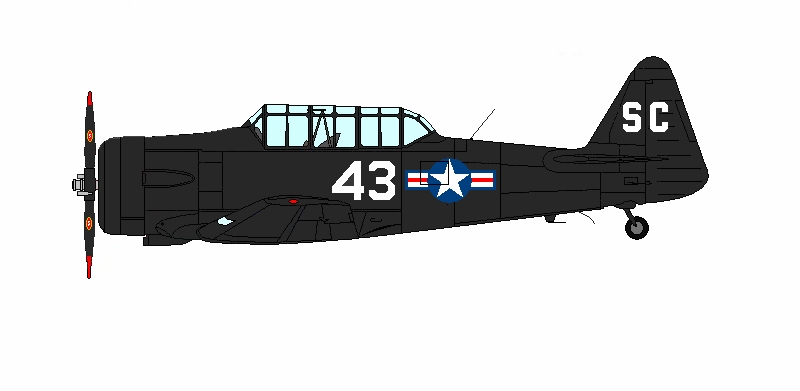
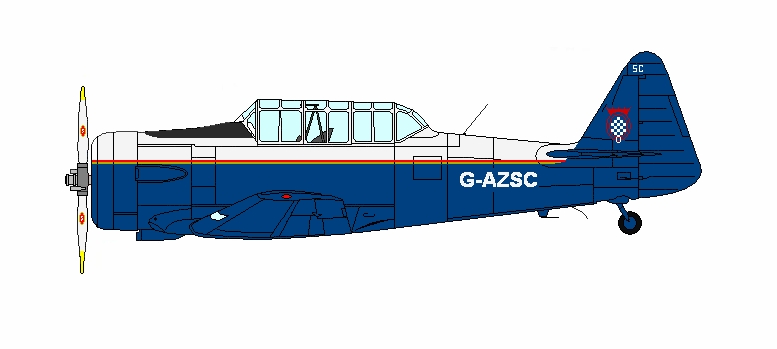
............Well, maybe someday
|

